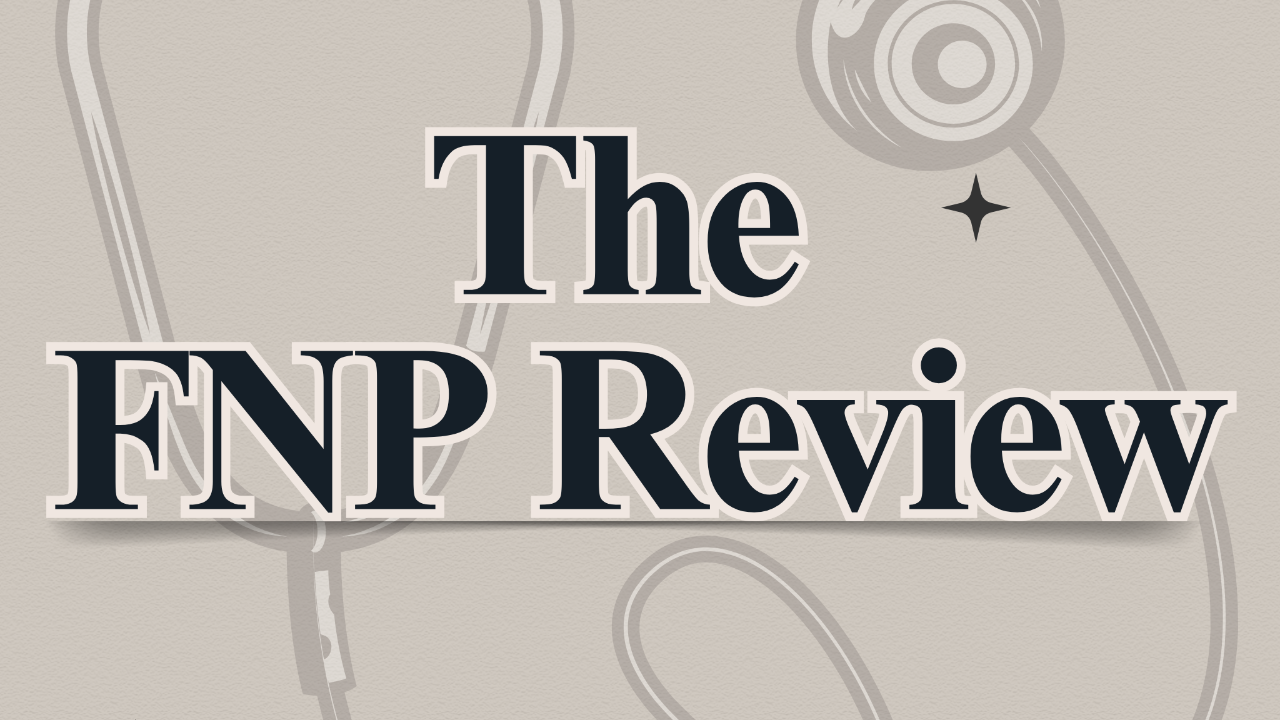
How to Pass the FNP Boards on the First Try: A Complete Guide for Future Nurse Practitioners
If you’re preparing for your Family Nurse Practitioner (FNP) boards, you’re probably feeling a mix of excitement, overwhelm, and pressure.
You want to do this right. You want a clear plan. And you want to walk into your exam knowing exactly what to expect — and walk out seeing that beautiful word: PASS.
As a Board-Certified FNP and co-creator of The FNP Review, I’ve helped thousands of future NPs prepare for the AANP and ANCC exams with confidence, clarity, and strategy. This guide breaks down the proven study methods, high-yield content areas, and exam-day strategies that will help you pass your FNP boards on the first attempt.
Whether you're 12 weeks out or 12 days out, this step-by-step breakdown gives you everything you need to start studying smarter — not harder.
What Makes the FNP Board Exam Difficult?
The AANP and ANCC exams are not like nursing school exams.
They test:
-
Clinical reasoning
-
Differential diagnosis
-
Pharmacology & prescribing safety
-
Primary care management across the lifespan
-
Prevention, screening, and health promotion
The biggest challenges students face include:
-
Not knowing what’s high-yield
-
Studying in a disorganized way
-
Memorizing instead of understanding
-
Not practicing enough exam-style questions
-
Overwhelm and study fatigue
The good news?
All of these can be fixed with the right strategy and resources.
Step 1: Know Exactly What’s on the FNP Board Exam
Both exams cover similar primary-care topics, but the weighting is different.
AANP Exam Breakdown
-
Assessment – 35%
-
Diagnosis – 25%
-
Plan – 22%
-
Evaluation – 18%
ANCC Exam Breakdown
-
Clinical management – 69%
-
Professional role & leadership – 31%
High-Yield Systems for Both Include:
-
Cardiology (EKGs, murmurs, HTN, HLD)
-
Respiratory (asthma, COPD, CAP)
-
Endocrine (DM, thyroid)
-
GI (abdominal pain patterns, hepatitis)
-
GU/Renal (pyelonephritis, UTIs, BPH)
-
Women’s health & pregnancy
-
Pediatrics
-
Dermatology
-
Infectious disease & antibiotics
Step 2: Build a Strategic Study Plan
A solid plan prevents burnout and keeps you on track.
The Ideal FNP Study Schedule Includes:
-
3–5 days/week of focused studying
-
Daily review of rapid-recall facts
-
Practice questions 2–3x/week
-
Weekly clinical reasoning cases
-
A mixture of video, reading, and active recall
Inside The FNP Review, we structure your plan so that every day has:
-
A high-yield video lesson
-
A quick rapid recall deck
-
Case studies to apply what you learned
-
A warm-up question set
-
A short review quiz
This type of structured repetition is what produces consistent first-time pass rates.
Step 3: Learn High-Yield Exam Patterns
The exam LOVES patterns. Here are a few examples:
Hypertension
-
First-line: Thiazide diuretics, ACE inhibitors, ARBs
-
Black patients: Thiazides or CCBs
-
Pregnancy: Labetalol, nifedipine, methyldopa
Murmmur Patterns
-
Aortic stenosis: crescendo-decrescendo + radiates to neck
-
Mitral regurgitation: holosystolic + radiates to axilla
-
Mitral stenosis: opening snap
Diabetes
-
A1C diagnosis ≥ 6.5%
-
First-line: Metformin
-
Add GLP-1 or SGLT2 for CV benefit
UTI vs Pyelonephritis
-
Pyelo = fever, CVA tenderness, systemic symptoms
-
Requires oral or IV antibiotics depending on severity
These are the types of connections the exam expects you to make quickly.
Step 4: Practice Questions — But the Right Way
Doing 1,000 questions doesn’t help if you don’t learn from them.
What Actually Improves Scores
-
Reviewing every rationale
-
Understanding why wrong answers are wrong
-
Identifying your weak areas and re-studying those systems
-
Reinforcing knowledge with rapid-recall or case studies
This is why our qbank and mini-cases walk you through:
-
The correct answer
-
Why it’s correct
-
Why each wrong answer is wrong
-
Clinical pearls to remember
-
Keywords to watch for
Step 5: Prepare for Exam Day
A calm brain is a sharp brain.
Exam-Day Tips
✔️ Sleep 7–8 hours
✔️ Eat something with protein & carbs
✔️ Wear layers
✔️ Use the tutorial time to breathe
✔️ Flag difficult questions
✔️ Trust your first instinct
And remember:
You don’t have to know everything.
But you DO need a system that teaches you what matters most.
Common Questions About the FNP Exam
How long should I study?
Most students study 6–8 weeks, but it varies based on:
-
How strong your foundation is
-
Whether you’re working while studying
-
How comfortable you are with clinical content
Should I choose AANP or ANCC?
Choose AANP if you prefer purely clinical questions.
Choose ANCC if you want a mix of clinical + professional role.
What’s the pass rate?
Pass rates change yearly, but on average:
-
AANP: ~80–86%
-
ANCC: ~75–81%
Students using structured programs (videos + qbank + books) typically score higher.
Final Thoughts: You Can Do This
Every single FNP who passed before you once felt exactly like you do right now:
uncertain, overwhelmed, and worried they weren’t studying “right.”
The truth?
Passing your FNP boards doesn’t come from perfection.
It comes from clarity, strategy, and consistency.
If you’d like more help — including:
-
Binge-worthy video lessons
-
High-yield rapid recall decks
-
Mini cases
-
Illustrated books
-
A qbank
-
Practice exams
-
Custom study plans
— you can explore The FNP Review Board Review Study System, the first all-in-one FNP study system created by a quad-board-certified physician and a board-certified FNP- and is the ONLY thing you need to pass your exam.
Study confidently.
Pass with clarity.
Become the NP you were meant to be.







